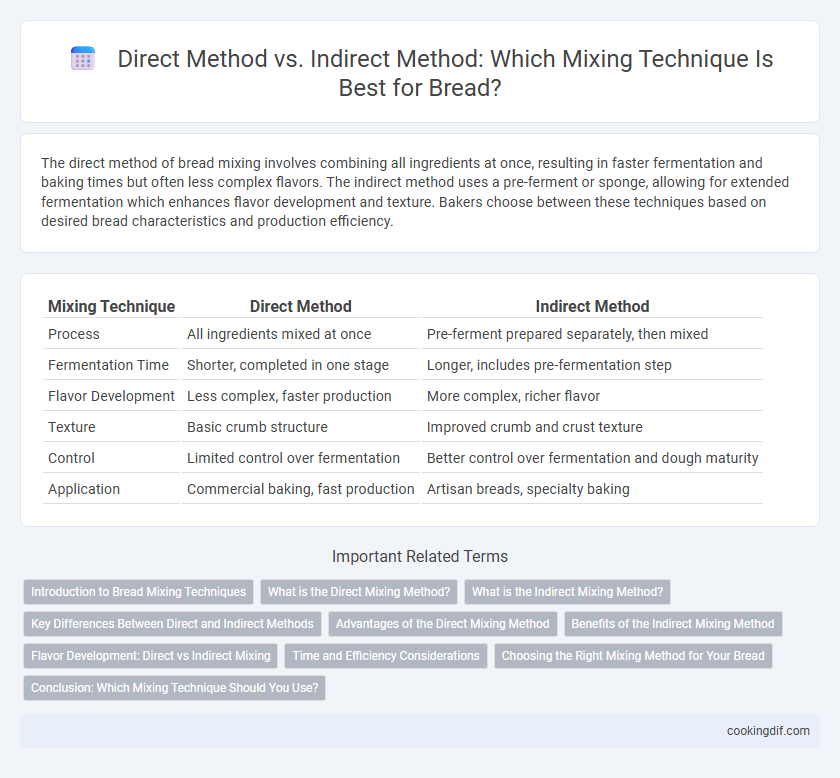The direct method of bread mixing involves combining all ingredients at once, resulting in faster fermentation and baking times but often less complex flavors. The indirect method uses a pre-ferment or sponge, allowing for extended fermentation which enhances flavor development and texture. Bakers choose between these techniques based on desired bread characteristics and production efficiency.
Table of Comparison
| Mixing Technique | Direct Method | Indirect Method |
|---|---|---|
| Process | All ingredients mixed at once | Pre-ferment prepared separately, then mixed |
| Fermentation Time | Shorter, completed in one stage | Longer, includes pre-fermentation step |
| Flavor Development | Less complex, faster production | More complex, richer flavor |
| Texture | Basic crumb structure | Improved crumb and crust texture |
| Control | Limited control over fermentation | Better control over fermentation and dough maturity |
| Application | Commercial baking, fast production | Artisan breads, specialty baking |
Introduction to Bread Mixing Techniques
Direct method for bread mixing involves combining all ingredients in one step, resulting in faster preparation and a tighter crumb structure. Indirect method utilizes a preferment or sponge, which enhances flavor development and improves dough extensibility through fermentation. Both techniques influence bread texture and taste by controlling fermentation time and yeast activity.
What is the Direct Mixing Method?
The Direct Mixing Method involves combining all ingredients--flour, water, yeast, salt, and sometimes fat--at once to form the dough, which simplifies and speeds up the bread-making process. This technique is favored for producing fresh bread quickly without extended fermentation times, making it suitable for certain bread types like sandwich loaves and rolls. The method results in a softer crumb and lighter crust due to its shorter fermentation and proofing stages compared to indirect methods.
What is the Indirect Mixing Method?
The indirect mixing method in bread-making involves preparing a sponge or preferment separately before combining it with the remaining ingredients, which enhances fermentation and flavor development. This technique improves dough strength and gas retention, resulting in a bread with better texture and enhanced aromatic qualities. Bakers often use the indirect method to extend fermentation time and achieve a more complex, richer taste compared to the direct mixing method.
Key Differences Between Direct and Indirect Methods
The direct method for bread mixing combines all ingredients at once, resulting in a faster process with a shorter fermentation time and a more straightforward workflow. The indirect method involves preparing a preferment or sponge separately, which enhances flavor development, improves dough texture, and extends shelf life due to longer fermentation. Key differences include fermentation duration, flavor complexity, and production time, with the indirect method favoring artisan-style breads and the direct method suited for quicker, large-scale baking.
Advantages of the Direct Mixing Method
The direct mixing method in bread making offers significant advantages such as faster production time and simplified process management by combining all ingredients in a single step. This technique enhances yeast activity, leading to improved fermentation control and more consistent dough quality. It also reduces the risk of contamination and ingredient degradation, ensuring higher product safety and shelf life.
Benefits of the Indirect Mixing Method
The indirect mixing method enhances dough fermentation by allowing yeast to develop slowly during a pre-ferment stage, resulting in improved flavor complexity and better crumb structure. This technique increases dough extensibility and gas retention, leading to a lighter, airier bread with a more open texture. Bakers benefit from greater control over fermentation timing, which reduces the risk of overproofing and improves overall dough consistency.
Flavor Development: Direct vs Indirect Mixing
Direct mixing method involves combining all ingredients at once, resulting in faster fermentation but less complex flavor development. Indirect mixing incorporates a preferment or sponge stage, allowing extended fermentation that enhances yeast activity and produces richer, more nuanced flavors. Bakers often prefer indirect mixing for artisan breads to achieve superior taste and aroma profiles.
Time and Efficiency Considerations
The direct method for bread mixing involves combining all ingredients at once, resulting in a faster process that reduces total production time by eliminating fermentation downtime. The indirect method requires preparing a preferment first, which extends the overall time but improves dough flavor and aroma due to longer fermentation periods. Efficiency gains in the direct method suit high-volume baking, whereas the indirect method benefits artisanal or specialty bread with enhanced sensory qualities.
Choosing the Right Mixing Method for Your Bread
Choosing the right mixing method for bread depends on desired texture and fermentation time; the direct method combines all ingredients at once for quicker preparation and a more robust crumb, while the indirect method involves pre-ferments like a sponge or poolish to enhance flavor and improve dough strength. The indirect method requires longer fermentation but results in better gluten development and complex taste, ideal for artisanal or sourdough breads. Evaluate factors like available time, desired crumb structure, and flavor complexity to select the optimal mixing technique for your bread recipe.
Conclusion: Which Mixing Technique Should You Use?
The choice between direct and indirect mixing methods depends on your desired bread texture and fermentation speed. Direct mixing offers simplicity and faster production by combining all ingredients at once, ideal for basic loaves, while indirect mixing uses pre-ferments like sponge or poolish to enhance flavor complexity and improve crumb structure. Bakers aiming for artisanal quality and richer taste often prefer the indirect method despite longer preparation times.
Direct method vs Indirect method for mixing technique Infographic

 cookingdif.com
cookingdif.com